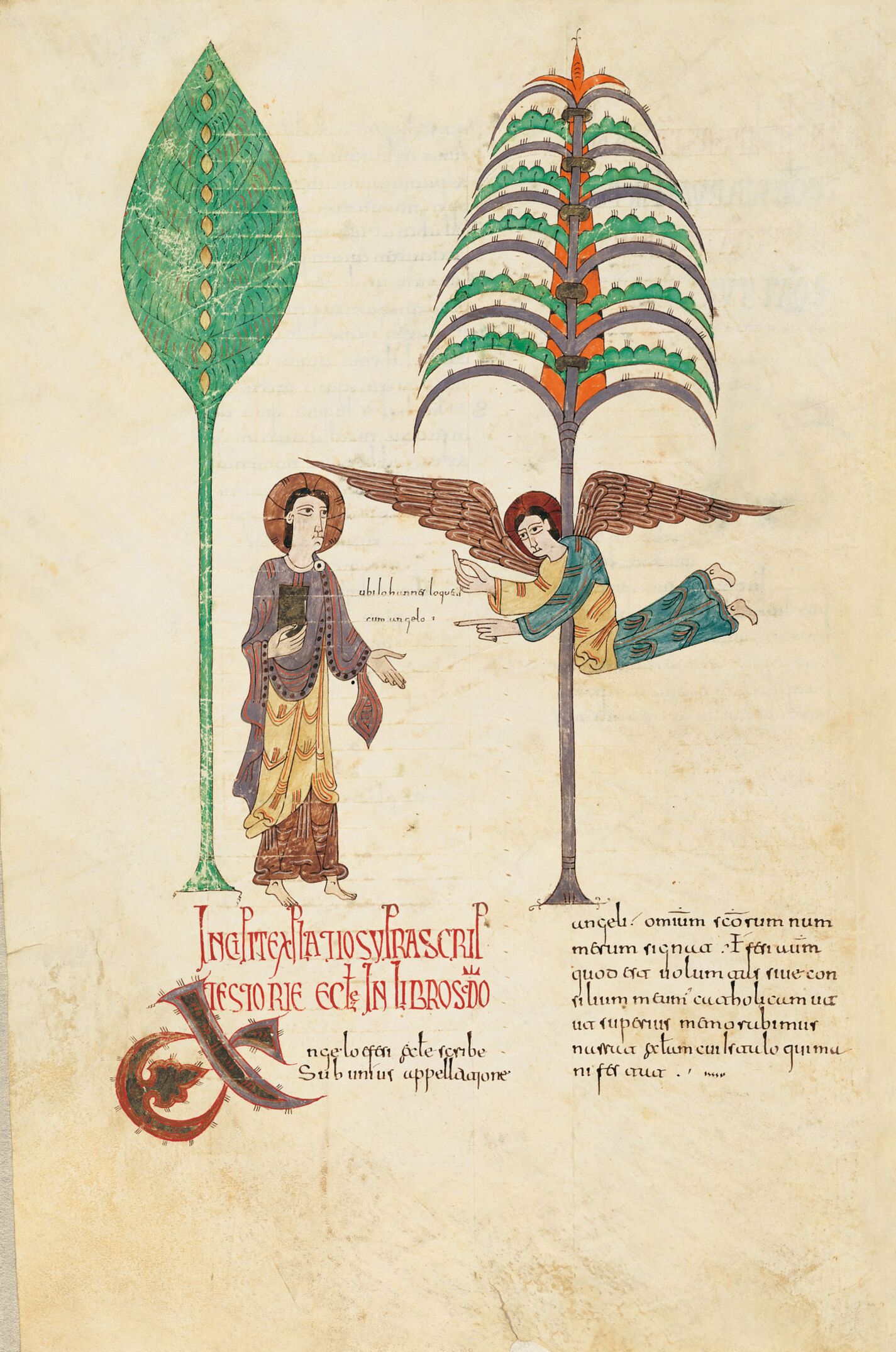The Gerona codex is the only Beatus – apart from its copy, the Turin Beatus (ff. 55v-56r) – in which this image covers two folios. This is probably because the copyist left a blank space on the corresponding verso folio in the Morgan Beatus (f. 47v) for reasons concerning the text, which was used by Maius to draw certain abstract elements which were undoubtedly adopted by the Tábara Beatus, whilst En chose to make the illustration look natural by eliminating the abstract drawings. Folio 70v depicts the delivery of the message with St John on the left holding a book in his hand and the flying angel on the right posed as if in conversation. Both are framed by a tree with a lanceolate crown and another, very simple, triangular tree with branches and leaves similar to those on the palm tree (f. 147v), which are perhaps of a symbolic nature. Between the two figures, the words “ubi iohannes loquens/cum angelo” can be read. These legends do not simply identify the figures but also explain the action taking place. In the Gerona Beatus, iohannes is nominative being the subject carrying out the action of delivering the news and addressing – loquens – the angel – cum angelo. Depicted on folio 71r is the church of Ephesus, “aeclesia efesi” as it says inside, represented as a highly imaginative temple flanked by two stylised and very decorative trees with a large central nave set between two side apses with arches or galleries closed off by blinds, and a sanctuary, identified by the curtains that were closed at specific moments of the eucharistic sacrifice, with an altar and chalice both made of gold and all set beneath a wide, horseshoe arch. The roof of the temple is very complex being pyramidal in shape and having lateral embellishments resembling wavy, oriental-style horns. The construction is set upon a stylised element which, in comparison with the Turin Beatus, looks like a crypt set in the rock of a mountain but with a predominant decorative and imaginary character.
Carlos Miranda García-Tejedor
Doctor in History
(Fragment of the Girona Beatus commentary volume)

The Gerona codex is the only Beatus – apart from its copy, the Turin Beatus (ff. 55v-56r) – in which this image covers two folios. This is probably because the copyist left a blank space on the corresponding verso folio in the Morgan Beatus (f. 47v) for reasons concerning the text, which was used by Maius to draw certain abstract elements which were undoubtedly adopted by the Tábara Beatus, whilst En chose to make the illustration look natural by eliminating the abstract drawings. Folio 70v depicts the delivery of the message with St John on the left holding a book in his hand and the flying angel on the right posed as if in conversation. Both are framed by a tree with a lanceolate crown and another, very simple, triangular tree with branches and leaves similar to those on the palm tree (f. 147v), which are perhaps of a symbolic nature. Between the two figures, the words “ubi iohannes loquens/cum angelo” can be read. These legends do not simply identify the figures but also explain the action taking place. In the Gerona Beatus, iohannes is nominative being the subject carrying out the action of delivering the news and addressing – loquens – the angel – cum angelo. Depicted on folio 71r is the church of Ephesus, “aeclesia efesi” as it says inside, represented as a highly imaginative temple flanked by two stylised and very decorative trees with a large central nave set between two side apses with arches or galleries closed off by blinds, and a sanctuary, identified by the curtains that were closed at specific moments of the eucharistic sacrifice, with an altar and chalice both made of gold and all set beneath a wide, horseshoe arch. The roof of the temple is very complex being pyramidal in shape and having lateral embellishments resembling wavy, oriental-style horns. The construction is set upon a stylised element which, in comparison with the Turin Beatus, looks like a crypt set in the rock of a mountain but with a predominant decorative and imaginary character.
Carlos Miranda García-Tejedor
Doctor in History
(Fragment of the Girona Beatus commentary volume)